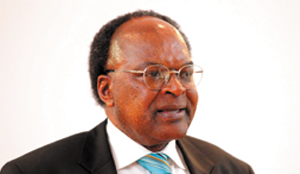By MAIMBOLWA MULIKELELA-
ZAMBIA’s international reserves have declined to US$2.673 billion from $2.751 billion recorded at the end of January this year, due to foreign exchange sales which supported payments related to oil procurement, the Bank of Zambia (BoZ) has said.
The central bank has also said Zambia’s economic prospects will remain strong in 2014, driven by increased economic activities in key productive sectors such as agriculture, mining, manufacturing and construction.
BoZ governor Michael Gondwe said during a Press briefing in Lusaka yesterday that, reserves declined to $2.673 billion at February 28, 2014 from $2.751 billion as recorded at the end of January this year.
Dr Gondwe explained that, the decline was mainly due to foreign exchange sales which were aimed at supporting the market and payments related to oil procurement.
“Our objective for 2014 will be to increase international reserves to cover three months of imports and contain overall budget deficit to no more than 6.6 per cent of GDP,” he said.
He said the three month import cover had been at a comfortable position, given the fact the export sector was performing fairly well with a strong growth export trajectory.
“In order to support the relatively low supply of foreign exchange and moderate volatility in the foreign exchange market, the Bank of Zambia has to date sold $178.0 million to the market,” Dr Gondwe said.
The Central Bank governor said preliminary data indicates that Zambia recorded an unfavourable Balance of Payment (BoP) performance in 2013 compared to 2012.
An overall BoP deficit of $344.9 million was registered compared with a surplus of $726.7 million registered in 2012.
Dr Gondwe said increased activities in the key sectors will increase economic prospects for the country as it will be driven strongly by activities in sectors such as mining, manufacturing, construction and agriculture.
Zambia’s macro-economic objective for 2014 would be to achieve Gross Domestic Product (GDP) of more than 7 per cent and attain end year inflation of no more than 6.5 per cent.
Dr Gondwe said growth in the agriculture sector would be driven by good weather patterns and the Government’s Farmer Input Support Programme (FISP).
He said mining and manufacturing industries are expected to benefit from increased capital imports which would push up the capacity utilisation, particularly among most mines.
Dr Gondwe said with increased output in the growth sectors, Zambia’s external sector was projected to improve, supported by continued growth of non-traditional exports (NTEs).
“Increased economic activities in the productive sectors such as mining should support improved performance of the foreign exchange market,” Dr Gondwe said.
Preliminary data indicates that Zambia’s economy had remained strong in 2013, with GDP growth of 6.5 per cent compared with 7.3 per cent in 2012.
Sustained growth in the said sectors was critical for higher productivity as this would have a bearing on the exchange rate movements.
Dr Gondwe said recent developments in the foreign exchange markets have raised concerns to the Zambian people and the Central bank has put in place measures to support the local unit.







